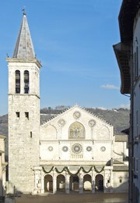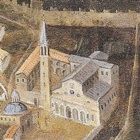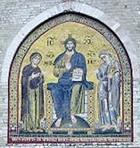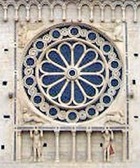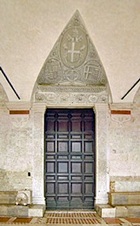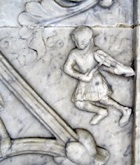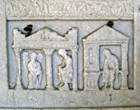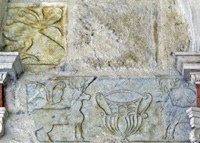Facade
The facade must have been largely complete by 1207, when the mosaic of the Deesis, which is dated by inscription, was executed (see below).
This detail from a painting of Spoleto in ca. 1636 shows the facade of the Duomo just before the re-modelling of 1638-44. The facade was subsequently modified as part of this re-modelling to reflect the fact that the nave was widened and the aisles were increased in height.
at Spoleto
(now in the Pinacoteca ?)
Deesis (1207)
The magnificent mosaic on the facade depicts Christ the Redeemer with the Virgin and St John the Baptist. In this Byzantine iconography, known as the Deesis (Greek for prayer), the Virgin and St John intercede with Christ on behalf of mankind.
The inscription below gives the date of the mosaic. It also says that "Doctor Solsternus" made it in the modern style and identifies three of the men who worked on it: Palmerius de Saso; Transericus Enrici; and Diutisalve Pingurini.
The mosaic has been restored on a number of occasions, including in 1927, when the head of St John the Baptist had to be replaced. The most recent restoration was carried out in 1976.
Central Rose Window (ca. 1207)
The central rose window, which has a diameter of some 4 meters, remains in its original location. It also retains its original appearance, despite successive restorations, the most recent of which was carried out in the 1990s.
The window is set above an architrave that is supported by small columns, two of which are replaced by male figures. It is enclosed in a mosaic frame with the symbols of the Evangelists in the spandrels.
Portal (13th century)
The central portal has fine reliefs:
-
✴the architrave is modelled on that of the central portal of San Salvatore;
-
✴the left jamb bears the signature Gregorius Melioranzio near a small figure on the right playing a violin (about half way up); and
-
✴the right jamb has worn reliefs at the bottom:
-
-
•another figure in a building, perhaps St Joachim being expelled from the Temple.
Portico (1491-1504)
The original portico was demolished in 1491 and rebuilt in its present form by Pippo di Antonio and Ambrogio di Antonio Barocci. It is flanked on the left by the base of the campanile and on the right by the Cappella dell' Assunta, one of the Eroli Chapels.
Campanile
The campanile is in the form of two co-axial square towers with a staircase that winds up inside the space between them. Recent analysis suggests that its lower part pre-dates the rest of the Duomo. It was built using material that was largely recovered from earlier buildings, including the earlier Duomo, the demolished Palazzo Vescovile and the city wall. Among the easiest to see are plutei (6th century AD) on the wall inside the portico, which depict:
-
✴part of a peacock (above, to the left); and
-
✴two deer approaching a chalice.
The plutei are actually identical in size, although neither is now fully visible. The upper one actually depicts two peacocks approaching a chalice. Both reliefs are symbolic of eternal life.
A stone inscribed with the name of Bishop Lotharius (1175-8) that has been found embedded in the campanile [where ??] seems to have been re-used as part of repairs to the campanile carried out after the sack of 1155. The upper part was rebuilt in 1512-5.
Pope Pius IX, who had been Bishop of Spoleto in 1827-32, paid for the restoration of the campanile in 1847.


